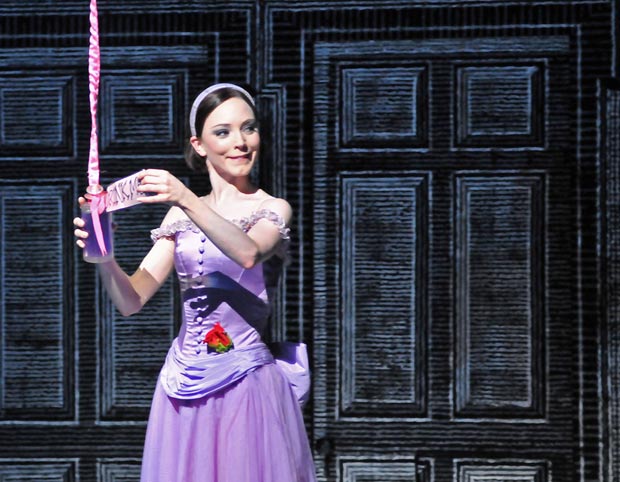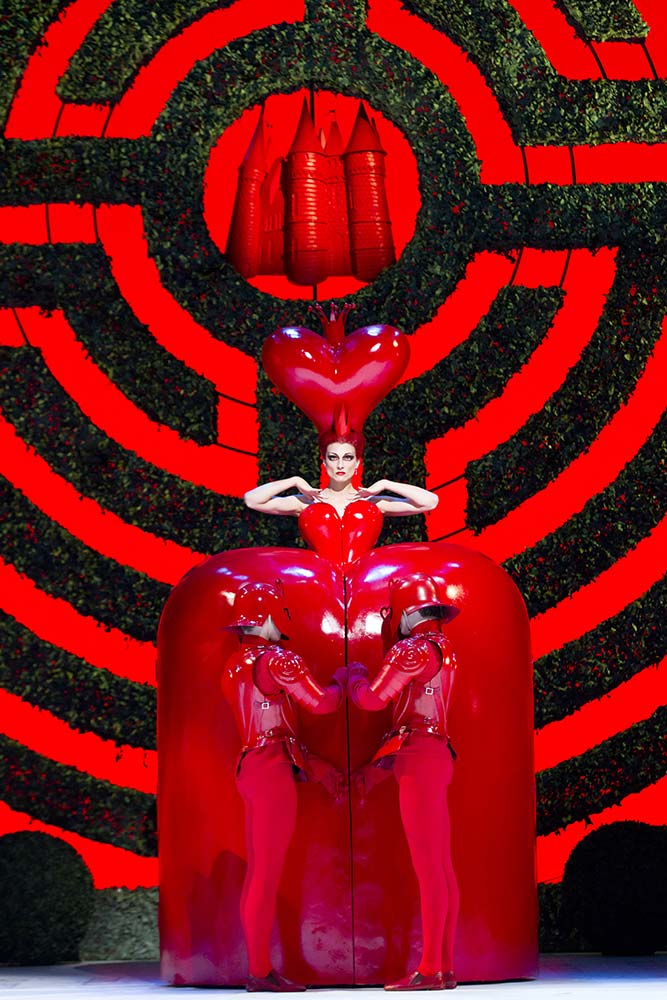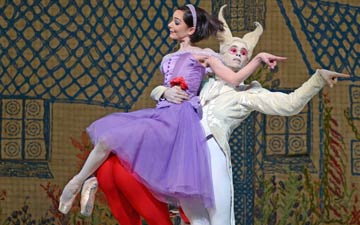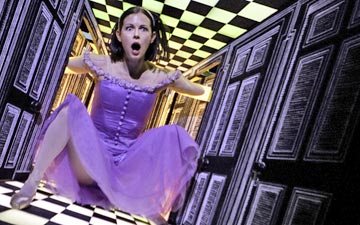
© Dave Morgan, by kind permission of the Royal Opera House. (Click image for larger version)
Royal Ballet
Alice’s Adventures in Wonderland
London, Royal Opera House
15 March 2013
www.roh.org.uk
Dave Morgan picture galleries:
Sarah Lamb & Steven McRae cast, 2012
Beatriz Stix-Brunell & Rupert Pennefather, 2013
Back for its third sold-out run and playing to ecstatically cheering audiences, Christopher Wheeldon’s Alice’s Adventures in Wonderland has established itself as a huge success for the Royal Ballet and is clearly going to be with us for many years to come. Deservedly so, in a lot of ways: it’s a wonderful show – a technical spectacle like no other the company has ever produced, with juicy roles for a wide range of dancer-types, an instantly accessible score, and a story that everyone at least thinks they know. But…

© Dave Morgan, by kind permission of the Royal Opera House. (Click image for larger version)
…. the synopsis in the programme book is full of ellipses like that and they serve to highlight one of the major flaws of the piece: without Lewis Carroll’s written narrative, much of the ballet consists of a series of unrelated numbers. Some of them are so clever in themselves that you either don’t notice that or you don’t care, but the weaker ones – the Caucus race for instance – drag terribly, and if you haven’t picked up all the clues scattered in the opening scene you may find yourself watching the Caterpillar episode, for instance, and wondering what on earth it’s all about. Wheeldon’s attempt to provide a unifying thread through Alice’s love story works to some extent but the downside is that by making his heroine into the ubiquitous ballet girl-on-the-verge-of-womanhood he deprives us of the grumpy, opinionated ten-year-old who so endearingly drives the original story. But…

© Dave Morgan, by kind permission of the Royal Opera House. (Click image for larger version)
…if you can watch the first two acts as a sort of variety show, the story does come together in the last scenes, and on the way you’ll have enjoyed at least one creation of near-genius in the brilliantly imagined Cheshire Cat. The one thing I’d really like to see sharpened up somehow is the very end of Alice’s dream, the dance translation of her “You’re nothing but a pack of cards”, which takes her back to the real world; although the consequence is cleverly done – she pushes the nearest card and they all fall in turn like dominoes – there’s not enough build-up for us to understand that it’s a key moment, a slight but crucial blurring of a big dramatic climax which was one of the problems I also noticed in Wheeldon’s Danish Sleeping Beauty, too. (I suspect, incidentally, that this and many other details may have been much clearer to those who have seen the television or DVD version, which can direct the attention to the part of the stage where the important action is happening.)

© Johan Persson, courtesy the Royal Opera House. (Click image for larger version)
The role of Alice herself must be one of the longest and most tiring in the company’s repertoire – she’s onstage almost the whole time and even when not dancing she’s permanently acting and reacting. Sarah Lamb stepped up into the first cast to replace Lauren Cuthbertson, unhappily still not fit after her long absence. She looks good – the dark wig somehow makes her features much clearer and therefore easier to read – and also seemed more outgoing and spontaneous than usual; my only wish was for a little more pronounced stroppiness to vary her slightly conventional girlish naughtiness. Federico Bonelli was the Knave of Hearts, the object of Alice’s developing affection – he’s charming, good-looking and amiable, all that could be asked for in what is actually a rather passive role for a hero.

© Johan Persson, courtesy the Royal Opera House. (Click image for larger version)
The later stages of the ballet are completely stolen from these two by Zenaida Yanowsky’s wildly extravagant Queen of Hearts. Her take-off of Aurora’s Rose Adagio is probably the most popular number in the whole piece, topped for me by her acknowledgement of the resulting ovation – it’s a joy to watch how she can work the house. Alexander Campbell seemed a little subdued as the Mad Hatter, a role tailored very closely to the talents of its originator, Steven McRae, and even Gary Avis struggled to make the grotesquely caricatured Duchess more than intermittently amusing. Edward Watson, though, was perfect as the White Rabbit, twitching and worrying, and also as the stray tourist with a camera in the last moments of the epilogue.

© Johan Persson, courtesy the Royal Opera House. (Click image for larger version)
So Wheeldon and his collaborators – Joby Talbot and Bob Crowley – have produced exactly what was presumably asked of them: an audience favourite which can be brought back year after year to play to guaranteed full houses and though I don’t believe it’s a great work of art, there’s no denying that it’s fun. Most of the time.

















Its surface brashness notwithstanding, Alice’s Adventures in Wonderland as related by Christopher Wheeldon is a show that repays repeated viewings – if only to disentangle the character doublings established at the tea-party in the first scene. I still struggle to call this Alice a ballet.
Wheeldon succeeds most when he diverges most from his source material – the framing scenes in Oxford, Alice’s romantic interludes with Jack, her yearning trio with her sisters, the set piece dance numbers – deals of playing cards, preening flamingoes, the waltzing flowers.
Even with a tale so crowded with non sequiturs the structure and dramatic logic of the first two acts is choppy, a succession of grotesques. Too many scenes outstay their purpose – and the inclusion of others – the caucus race, the duchess’ sausage factory, the trial – is incoherent. Other elements – the dancing topiary and white rose bushes – are a one trick joke.
This revival has lost some of its sheen. On repeated hearings, Joby Talbot’s score no longer sounds so special – but his voice is authentically his own. The stagecraft has lost some of its wizardry, and there was some lack of precision in the ensembles.
Yuhui Choe is not so gamine as earlier Alices. Her beautiful legs and feet put more emphasis on the choreography though she conveyed more of the hoyden than others. Compared to the roles’ creators, Nehemiah Kish has nothing of the laddish and technical insouciance as Jack. Ricardo Cervera is a less manic, warmer White Rabbit. Alexander Campbell is again defeated by the Mad Hatter.
Zenaida Yanowsky has burnished her portrayal of the Queen of Hearts to psychotic levels. But even she can make nothing of the tango with the executioner that follows the Sleeping Beauty spoof.
So – still a show that would look at home in the commercial world of the West End. As a ballet for a leading classical company I am less convinced. Wheeldon’s many quotes of English and classical ballets are less apparent this time around. Dancers have settled into the choreography, establishing their own character – though the enveloping costumes and wigs overwhelm even such normally vivid performers as Thomas Whitehead. Beyond the featured roles there is little that exploits the scale and talent of The Royal Ballet. The production’s surface effects still dominate.
“Would look at home in the commercial world of the West End”. I couldn’t agree more. Having seen and enjoyed the DVD of this production I was very disappointed by the often banal quality of the live experience last week (Sarah Lamb and Co).
Also it just seems a bit over-long and pointless. Yes, the effects people have gone to town, but frankly the West End does a better job of this kind of trickery and the more traditional solos and pas de deux looked completely out of place amongst the (superior) panto antics that surround it. Pleased that the house has been full for the many performances. The cash will be welcome to support more challenging work.